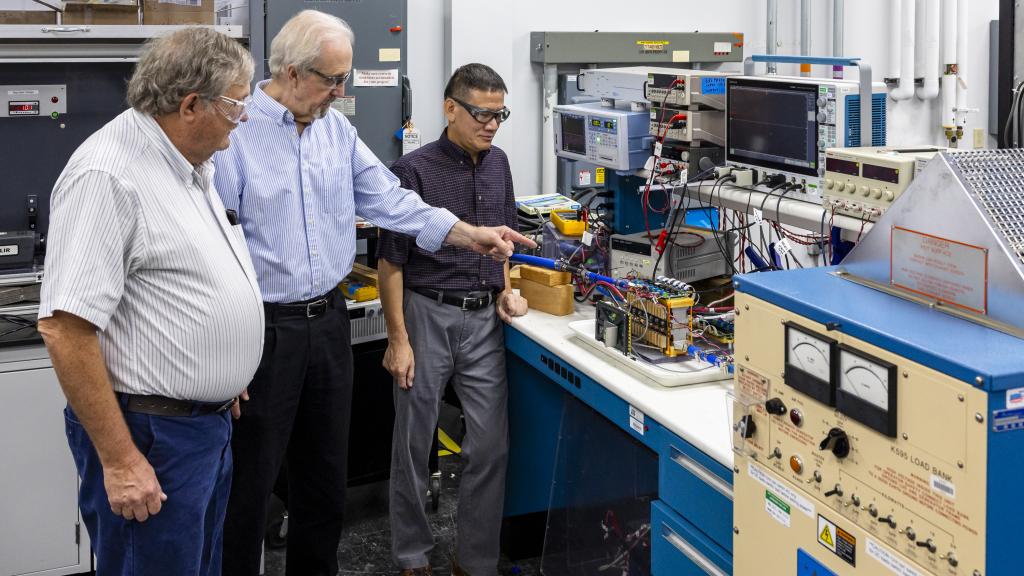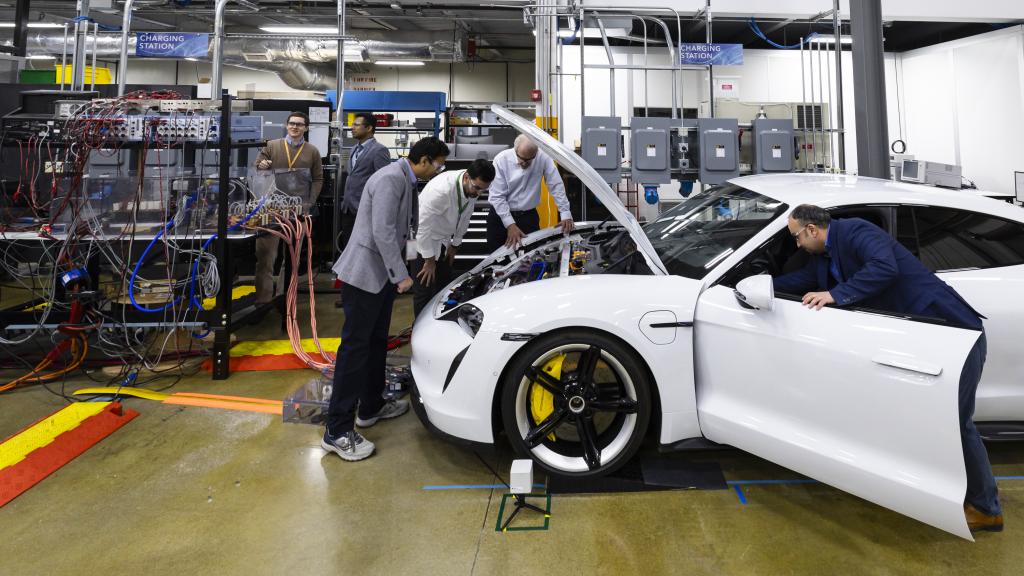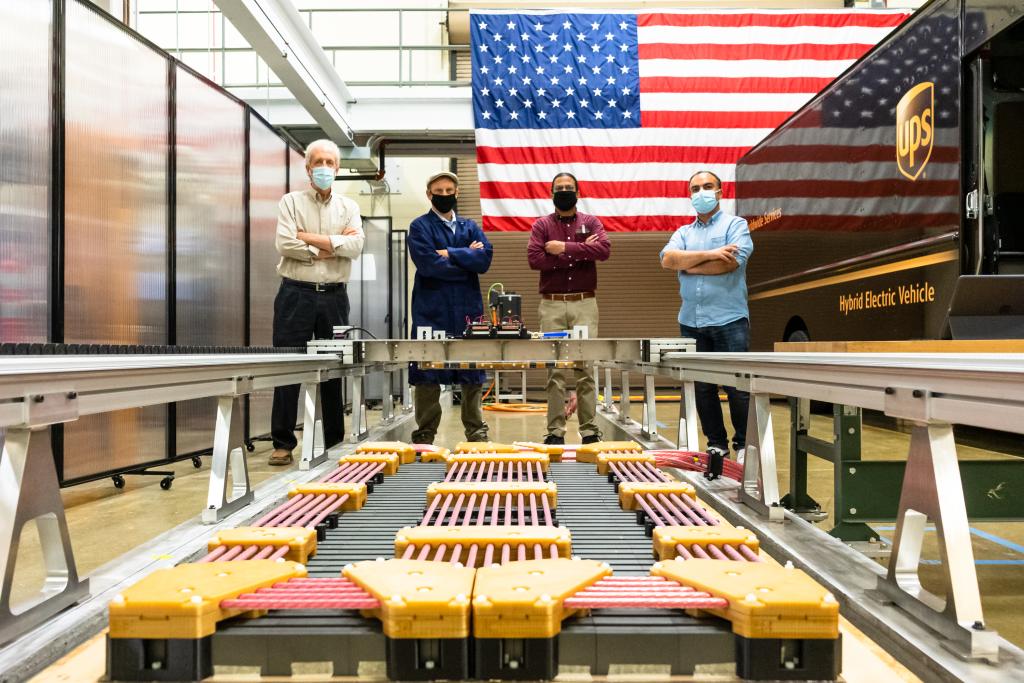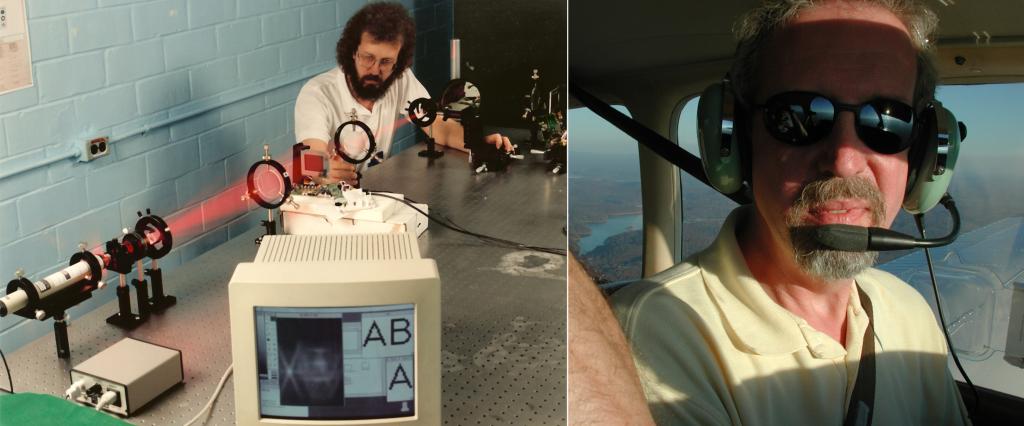Within the Vehicle Power Electronics group at the Department of Energy's National Transportation Research Center at Oak Ridge National Laboratory works an unassuming R&D staff member who has enabled groundbreaking and world-recording-setting scientific achievements.
Larry Seiber designs the hardware layout and assembles the inverters for the powertrains of electric vehicles. His steadfastness in building and testing these components to ensure they operate at the lightest weight and greatest efficiency possible helped ORNL achieve the first-ever wireless transfer of 270- kilowatt of power to an electric vehicle. It's an accomplishment that is likely to be cited in history books for decades to come.
On November 18, Seiber achieved his own personal historical milestone, celebrating 50 years at ORNL. Throughout five decades, he's worked for all the lab's operating contractors and his career even predates the Department of Energy, which was founded three years after he began his first job at the lab in 1974.
And Seiber has no intention of slowing down anytime soon.
"As long as I have the work environment, the people, I'll probably work until my health says you have to stop," Seiber said. "It's very motivating here; I actually look forward to coming to work and it is a pleasure to be part of this team."
ORNL Laboratory Director Stephen Streiffer said Seiber's years of service puts him in rare company.
"While we've had a few other staff members achieve 50 years with ORNL, it's a very small group, and they all have an extraordinary level of dedication to the mission of this lab," Streiffer said. "Larry has excelled in all areas, and we thank him for his service."

Road to electronics
Growing up in Lake City, Tennessee, now known as Rocky Top, Seiber knew about ORNL early on - his dad was a pipefitter for the lab. With his dad's encouragement, he decided to pursue an engineering career.
"I didn't know what I wanted to do, but dad, working around engineers every day, brought up electrical engineering and said I needed to try it. He thought I could do it because I'm patient and like to figure things out," Seiber said.
Taking his dad's advice, Seiber completed an associate of science in electronics technology degree from Roane State Community College, which led to his first job as a laboratory technician in the Centrifuge Division at the now decommissioned K-25 plant, operated by Union Carbide and part of the Oak Ridge Reservation of facilities, which includes ORNL. Today, the facility is part of the Heritage Center Industrial Park. The plant used the gaseous diffusion method to separate uranium-235 from uranium-238. For nine years Seiber calibrated equipment and built test circuit boards. He installed instrumentation to monitor the centrifuge machine performance and test the parameters during potential failure. It was in this role that Seiber made one of his most notable career contributions - testing a prototype drive-down cart for the centrifuge machine.
"We had a drive-down cart that we used to bring the speed of a centrifuge machine from top speed to zero in a safe and controlled fashion," he said. "There were always glitches and problems with it. People were looking at the hardware to solve the problem without success, so I started thinking maybe it was the software, but back then computer control was a new concept."
Seiber printed out the program and software language for the cart's Motorola 6800 microprocessor and, after painstakingly going through the lines of code, he identified the issue and re-wrote the software to solve the problem. Seiber said his first major career success was quickly followed by his first major disappointment.
"Within two weeks of solving the problem, the centrifuge program was stopped in favor of another program, so my success was never realized, really, and we all had to start looking for other jobs," he said. "It was disappointing to have to go somewhere else at that time, but it eventually led me to where I am today."
A move to another Oak Ridge Reservation facility, the Y-12 National Security Complex, in 1985 allowed Seiber to continue working with computers, providing software support and system maintenance for microprocessors as an engineering technologist. Promoted to staff engineer in 1994, Seiber went back to school, completing several engineering courses at the University of Tennessee. He was also introduced to power electronics and asked to design and build control panels for prototype testing of inverters, which are electronic devices that convert electricity from a direct current to an alternating current.
"I did some electronic design and development and one of the things we did at Y-12 was real-time welding control using lasers. We would compare a perfect weld image with the real-time image and then feed back to the machine what it needed to do to adjust to get that perfect image," Seiber said. "We were also responsible for developing sensors to monitor the stored uranium."

The electronic design work led to an offer in 2000 to join the power electronics and electric machinery group at ORNL as a research and development associate, where he later became a technical professional and remains today. For several years, he served as a project manager and principal investigator for characterizing prototype capacitors and magnets for hybrid electric vehicle drive systems.
Adapting to new technologies
Seiber arrived at ORNL at a time when the U.S. was just beginning to focus on clean and sustainable transportation and investigating how to develop affordable, emissions-free cars and light trucks. His ability to test and build electronic devices proved invaluable to the lab's participation in DOE's FreedomCAR program that was launched in 2002 with the goal to transition to advanced hybrid electric vehicles by 2015.
"I developed a program to characterize prototype capacitors and magnets that would need to be used in a hybrid electric vehicle-electric drive system," Seiber said. "This was new work for us. Had never been done. We had to make sure the capacitors could withstand extreme temperatures, too, so I developed the first testing procedure for that."
Capacitors are needed for hybrid electric vehicles to run efficiently when switching to a battery source. The electronic devices can store energy so that it can be quickly accessed to keep batteries operating within safe limits and extend their lifespan. Magnets, likewise, are a critical component for the electric motor, enabling power delivery from the battery to the wheels by generating the rotational force.
Seiber's procedure for keeping capacitors cool earned him his first team patent and set the stage for an even bigger challenge - building the hardware for wireless power transfer systems. At first, when he was asked to build the components in such a way that they were as lightweight as possible, he wasn't sure of the purpose.
"I was working on a different project, testing capacitors and magnets where we were evaluating the method of cooling a capacitor in liquid freon," he said. "Around that same time, the research team was doing a wireless power transfer using light bulbs, over a small gap of a few inches. I thought to myself, well, that's all well and good but what are we going to use this for?"
Seiber soon found out; he was tasked with building the inverter that would generate the high-frequency signal that a receiver could then pick up and use to receive power without wires. Using sketches and renderings from 3D-printed computer automated design files, Seiber painstakingly built it step by step, by hand.
"To build an inverter, there's cooling to consider, there's heat sinks that need to be looked at. And the supporting hardware and drive cards must be added, being mindful of methods to avoid electromagnetic interference," he explained. "Putting that package together cannot be rushed. I take time to look at each detail and think about what could happen, such as high-voltage arcing unless I insulate or isolate something.
"So far, every inverter system that I've built has worked the first time with no errors. That's something that I'm proud of," he said.
Seiber's inverters helped achieve the first 20-kW transferred to a sport utility vehicle in 2016. This success was followed by the benchtop lab testing of a 120-kW charge using conventional coil technology and a 20-kilowatt bi-directional wireless charging system installed on a UPS medium-duty, plug-in hybrid electric delivery truck in 2020. Seiber's work with the internal components also enabled a 100-kW transfer to a light-duty passenger vehicle in early 2024.

Dedication on land, in the air and at sea
Seiber's resume includes a long list of awards and honors for excellence in performance, including being a member of the team that received an R&D 100 Award for the compact and lightweight polyphase system that was used for the 270-kW power transfer. The R&D 100 Award, often referred to as the Oscars of innovation, is something Seiber said he never expected to see his name attached to.
ORNL's Associate Laboratory Director for Energy Science and Technology Robert Wagner said it's not surprising that Seiber's research has earned three patents and been an integral part of ORNL's wireless charging success. When Wagner was director of the National Transportation Research Center, he would add that Seiber was usually working on weekends, and they would often check on each other before going home for the day. When COVID-19 sent most employees home in 2020, Seiber worked every day onsite, making sure that projects stayed on track.
"Larry is dedicated to excellence and trusted to carry through with tasks that require attention to detail and perfection," Wagner said. "It's commendable that he has achieved 50 years."
Omer Onar, Seiber's group leader who also led the wireless power transfer research team, said Seiber has a talent for problem-solving and his ability to build components is an invaluable resource for ORNL.
"Any task we've given Larry, he follows through, on time and under budget, and it's precise and right the first time," Onar said. "He was critical to our wireless charging success."
Earlier this year, Onar tasked Seiber with pitching the wireless power transfer hardware component capability for use in a defense-related project. Seiber said it was the most challenging and stressful time in all his 50 years because future research depended on his presentation. To get through it, he said he leaned heavily on his faith for additional reassurance.
"I got on the plane to DC, had practiced my presentation over and over, had a nice PowerPoint prepared, but I found out they just wanted me to skip the formal presentation and have a discussion about our capabilities and answer their questions," he said. "I relaxed and we had a very good meeting. At the end of the day, they were very impressed with our capabilities and wanted to engage with us in research, which provided significant funding for our program."

In his spare time, Seiber continues to challenge himself. He became a private pilot and has taken numerous regional flights and even experienced mechanical failure inflight but landed safely. He's also a scuba diver with advanced rescue and dive-master certifications. He has dived in Key Largo and Bonaire in the Caribbean, swimming among sharks and barracudas and scouting out shipwrecks.
Seiber also makes time to give back locally and internationally.
"I've gone to Nicaragua three times on mission trips, pouring concrete pads, constructing homes and buildings and delivering food to very remote areas." he said. "And, locally, I've organized groups to feed the homeless in my hometown. I just enjoy helping others, I don't see myself ever sitting down and doing nothing because there's always something to learn, something to do, something that you can do that helps another person."
UT-Battelle manages ORNL for the DOE's Office of Science, the single largest supporter of basic research in the physical sciences in the United States. The Office of Science is working to address some of the most pressing challenges of our time. For more information, please visit energy.gov/science .






